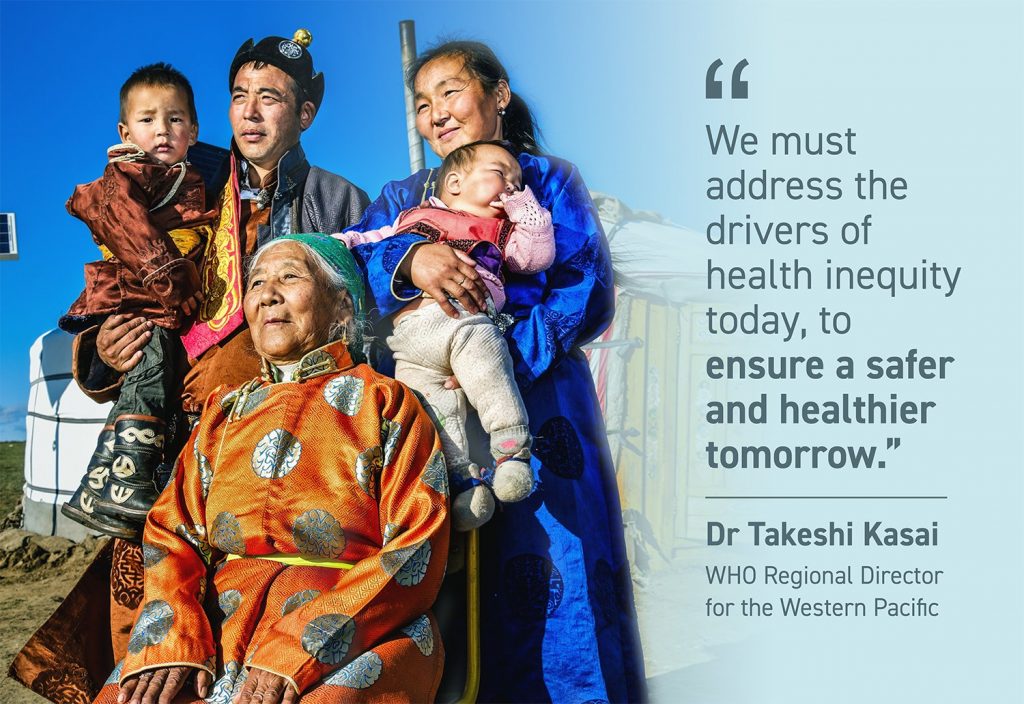In recent years, countries in the Western Pacific have experienced rapid economic growth, migration and urbanization. This created opportunities for better lives for many, but left others behind. The COVID-19 pandemic has undercut recent health gains, pushed more people into poverty and food insecurity, and amplified gender, social and health inequities.
This World Health Day, we’re calling for action to eliminate health inequities, as part of a year-long global campaign to bring people together to build a fairer, healthier world. The campaign highlights WHO’s constitutional principle that “the enjoyment of the highest attainable standard of health is one of the fundamental rights of every human being without distinction of race, religion, political belief, economic or social condition.”
The world is still an unequal one. The places where we live, work and play may make it harder for some to reach their full health potential, while others thrive. Health inequities are not only unjust and unfair, but they also threaten the advances made to date, and have the potential to widen rather than narrow equity gaps.
However, health inequities are preventable with strategies that place greater attention to improving health equity, especially for the most vulnerable and marginalized groups. COVID-19 has hit all countries hard, but its impact has been harshest on those communities which were already vulnerable, who are more exposed to the disease, less likely to have access to quality health care services and more likely to experience adverse consequences as a result of measures implemented to contain the pandemic.
That’s why we are calling on leaders to ensure that communities are at the forefront in decision-making processes as we move forward to a new future, and that everyone has living and working conditions that are conducive to good health. At the same time, we urge leaders to monitor health inequities, and to ensure that all people are able to access quality health services depending on their needs and values within their communities.

Facts and Figures:
- For the first time in 20 years, global poverty levels are predicted to rise and hinder the progress towards the Sustainable Development Goals1
- Up to 60% of people living in some countries of the Region lack coverage with essential health services2
- More than 1 billion people living in informal settlements or slums are facing increased challenges in preventing infection and transmission of the coronavirus3
- The Asia-Pacific region as a whole account for nearly 82.5 million or 32% of the world’s international migrants4
- 5.9 million children in the Asia-Pacific Region are at risk of not returning back to school due to the disruption to education and the economic impact of the pandemic4
- 52% of the Asia-Pacific population remains unconnected to the internet5
1 Profiles of the new poor due to the COVID-19 pandemic. World Bank; 2020 (http://pubdocs.worldbank.org/en/767501596721696943/Profiles-of-the-new-poor-due-to-the-COVID-19-pandemic.pdf, accessed 10 February 2021).
2 Universal health coverage in the Western Pacific (https://www.who.int/westernpacific/health-topics/universal-health-coverage)
3 Goal 11 Make cities and human settlements inclusive, safe, resilient and sustainable. In: United Nations Department of Economic and Social Affairs Sustainable Development [website]. 2020 (https://sdgs.un.org/goals/goal11, accessed 10 January, 2021)
4 Developing digital learning materials for ethnolinguistic minority children. UNESCO Bangkok Asia and Pacific Regional Bureau for Education [website]. 2020 (https://bangkok.unesco.org/index.php/content/developing-digital-learning-materials-ethnolinguistic-minority-children, accessed 10 February 2021).
5 Disaster-Responsive Social Protection: Lessons from COVID-19. UNDRR, FAO, ESCAP; 2020 ( https://www.undrr.org/media/47634/download, accessed 7 February 2021).





